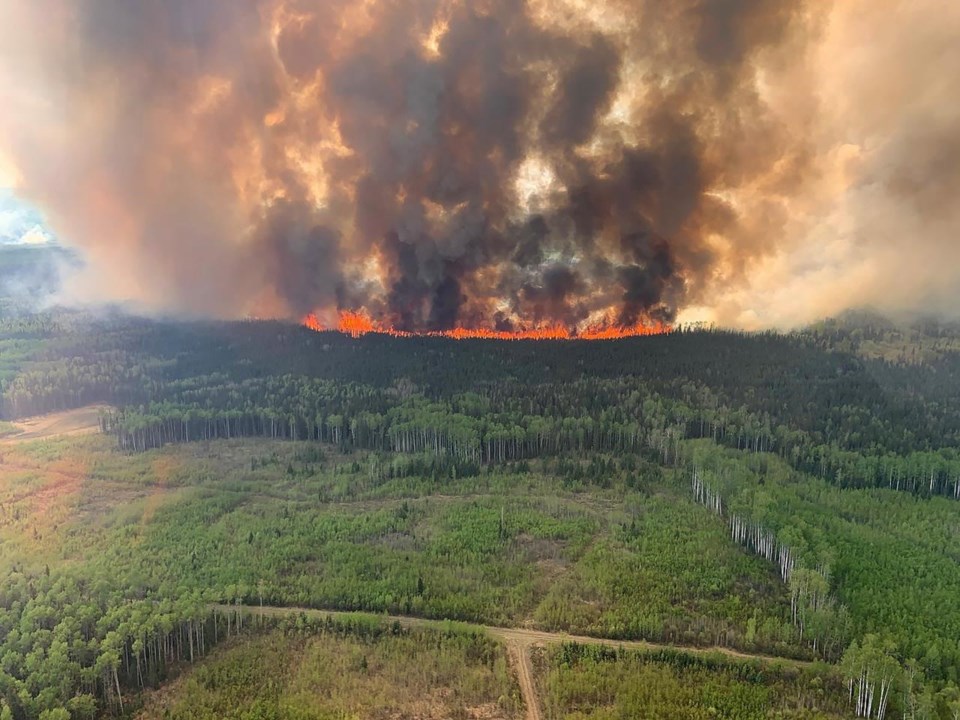Hot and dry conditions have worsened wildfires throughout Western Canada, forcing thousands from their homes and leaving many regions under a layer of smoke.
"Prayers are needed for rain," Chief Wilfred Hooka-Nooza of Dene Tha First Nation in northwestern Alberta said Tuesday.
Hundreds of people were forced earlier this week to flee Chateh, a community that is part of the First Nation, as a blaze approached.
Hooka-Nooza said the fire crept within 13 kilometres of the community and workers were using bulldozers to build a fireguard to keep flames at bay.
“The wind is in our favour at the moment, blowing in a different direction, but it could change," the chief said.
Roughly 2,500 people were fighting fires throughout Alberta, and 24 of 86 active wildfires were considered out of control as of Tuesday afternoon.
An email was sent to all Government of Alberta employees Tuesday asking anyone with firefighting experience to volunteer. Sixty additional firefighters from Ontario also arrived in the province.
"We are pulling out all the stops that we can to try and get as many experienced people on the front line that we can," said Forestry Minister Todd Loewen.
More than 19,470 people have been forced out of their homes, with Swan Hills, northeast of Edmonton, the latest community to order an evacuation Tuesday.
An evacuation order for Drayton Valley, where some people lost their homes as a wildfire tore through nearly two weeks ago, was partially lifted.
Wildfires have also been a concern for Alberta's neighbours, including the Northwest Territories, where the K'atl'odeeche First Nation and town of Hay River, about 120 kilometres from the Alberta boundary, are under evacuation orders. Changing winds allowed firefighters to reach more of that blaze on Tuesday, but it's still out of control.
A convoy of vehicles was allowed to leave a northern Saskatchewan village Tuesday after Buffalo Narrows issued a mandatory evacuation order. Mayor Sandy Ericson posted on social media that poor air quality due to smoke and the loss of electricity made it unsafe to stay.
Roy Cheecham drove along the highway near Buffalo Narrows around midnight and saw a forest of flames along the side of the road. Along the drive he saw flashes of fire burst into the smoky air from trees that had been engulfed.
"It's devastating," Cheecham said in a message online. "All that ground lost. All those affected. It's not a good situation."
The power outage means a lot of people didn't have a way to cook indoors and there were food shortages at retailers in and around the community, he said. Those lucky enough to have generators are using them to try to stop food from spoiling.
There were 28 wildfires burning in Saskatchewan on Tuesday.
The weather has not been co-operative in battling blazes in northern British Columbia, and officials there said an ongoing heat wave is increasing the fire risk further south.
"We are going to see challenging conditions today and for the next number of days," said Cliff Chapman, director of wildfire operations.
The city of Fort St. John, about 200 kilometres northwest of Grand Prairie, Alta., issued an evacuation alert for its roughly 21,000 residents in response to a wildfire that's more than 130 square kilometres in size. Chapman said winds were pushing flames away from the community Tuesday.
There were 63 wildfires burning across the province. More than 500 square kilometres have burned already this year in British Columbia, Chapman added, which is higher than the 10-year average of 110 square kilometres.
“We are challenged with the fire behaviour and the conditions that we see," he said.
An unusual May heat wave has spurred rising wildfire risk across the West as dozens of heat records were set or tied in B.C. and Alberta.
Environment Canada issued air quality statements stretching from the B.C. coast to Manitoba.
Wildfire smoke descended on Calgary with the sun appearing a vibrant red through the orange-tinged haze Tuesday morning. Environment Canada said people should take precautions.
Hooka-Nooza said the heat has been unprecedented and early this season, leaving the land in his region very dry.
"I have never seen that before way back then, in the years I used to do wildfire fighting," the chief said.
"I have never seen something this early into the spring.”
This report by The Canadian Press was first published May 16, 2023.
— With files from Chuck Chiang in Vancouver, Colette Derworiz in Calgary and Emily Blake in Yellowknife.
Kelly Geraldine Malone, The Canadian Press




